Secure Wireless 433CO Wireless Carbon Monoxide Sensor User Manual
Secure Wireless, Inc Wireless Carbon Monoxide Sensor
User Manual
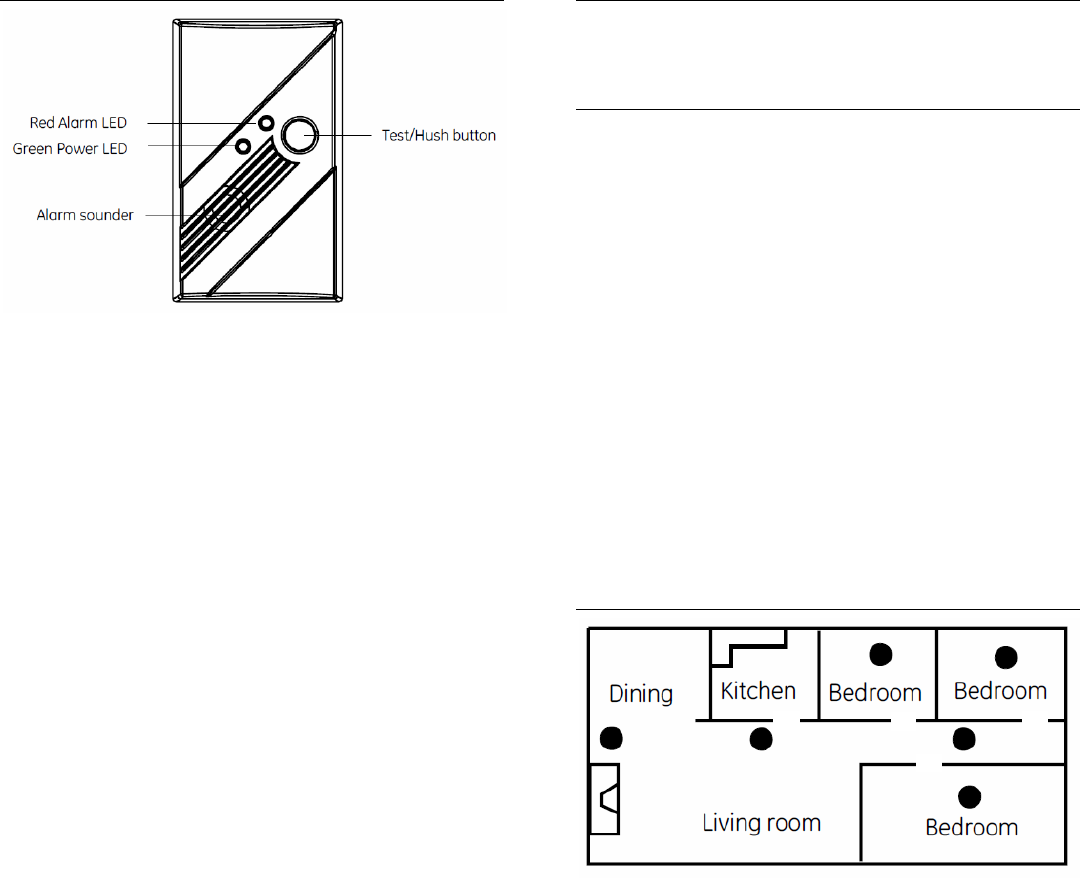
AT&T. All Rights Reserved. 1 P/N 0000 – Rev. A – 10 Oct 11
Carbon Monoxide Alarm Manual
Figure 1: Alarm Features
Attention: Please take a few minutes to thoroughly
read this guide which should be saved for future
reference and passed on to any subsequent owner.
This CO Alarm is only compatible with the Digital Life
Controller SKU #: RTL.69237 control panel(s). Refer to
the panel installation instructions for revision verification
details. It is currently not compatible with other control
panels. Please contact Technical Support for any
questions regarding compatibility.
Description
This wireless carbon monoxide (CO) Alarm monitors the
levels of CO gas and gives early warning when
potentially dangerous levels exist. It does not detect fire,
smoke, or any other gas. If a dangerous concentration of
CO is detected by patented and field-proven
electrochemical sensor, an LED indicator illuminates and
an internal siren is activated in Temporal 4 pattern. The
CO Alarm also transmits an alarm signal to the control
panel within 15 seconds of detecting dangerous
concentration of CO gas. The control panel activates its
internal siren and reports the alarm condition to the
central monitoring station (if the system is monitored).
The CO Alarm also detects low battery, wall tamper, and
sensor end-of-life. These trouble codes are transmitted
to the control panel which reports the condition to the
central monitoring station. The alarm automatically reset
when CO is no longer detected.
This wireless CO Alarm is Listed and compliant with the
ANSI/UL 2034 standard for CO Alarms. It is intended for
residential indoor dwelling unit applications and other
areas approved by the authority having jurisdiction
(AHJ). It is not intended for use in industrial applications.
WARNING: After seven years from initial power up, this
alarm will beep two times every 30 seconds to indicate
that it is time to replace the alarm. Replace the alarm
immediately! It will not detect CO in this condition.
To help identify the date to replace the alarm, an area
has been reserved on the side of the alarm. Write the
“replace by” date (seven years from power up) with a
permanent marker in the area provided.
Alarm location
CO Alarms should be mounted in or near bedrooms and
living areas. We recommend that you install an alarm on
each level of your home.
When choosing your installation locations, make sure
you can hear the alarm from all sleeping areas. If you
install only one CO Alarm in your home, install it near
bedrooms, not in the basement or furnace room.
Place the alarm out of reach of children. Under no
circumstances should children be allowed to handle the
CO Alarm.
Figure 2: Recommended locations
Locations to avoid
Improper location can affect the sensitive electronic
components in this alarm. To avoid causing damage to
the unit, to provide optimum performance, and to prevent
unnecessary nuisance alarms:
• Do not install in kitchens, garages, or furnace rooms
that may expose the sensor to substances that could
damage or contaminate it.
• Do not install in areas where the temperature is
colder than 40°F (4.4°C) or hotter than 100°F
(37.8°C) such as crawl spaces, attics, porches, and
garages.
• Do not install within 5 ft. of heating or cooking
appliances. (We recommend 15 ft. to prevent
nuisance alarms.)
Do not install near vents, flues, chimneys, or any
forced/unforced air ventilation openings.
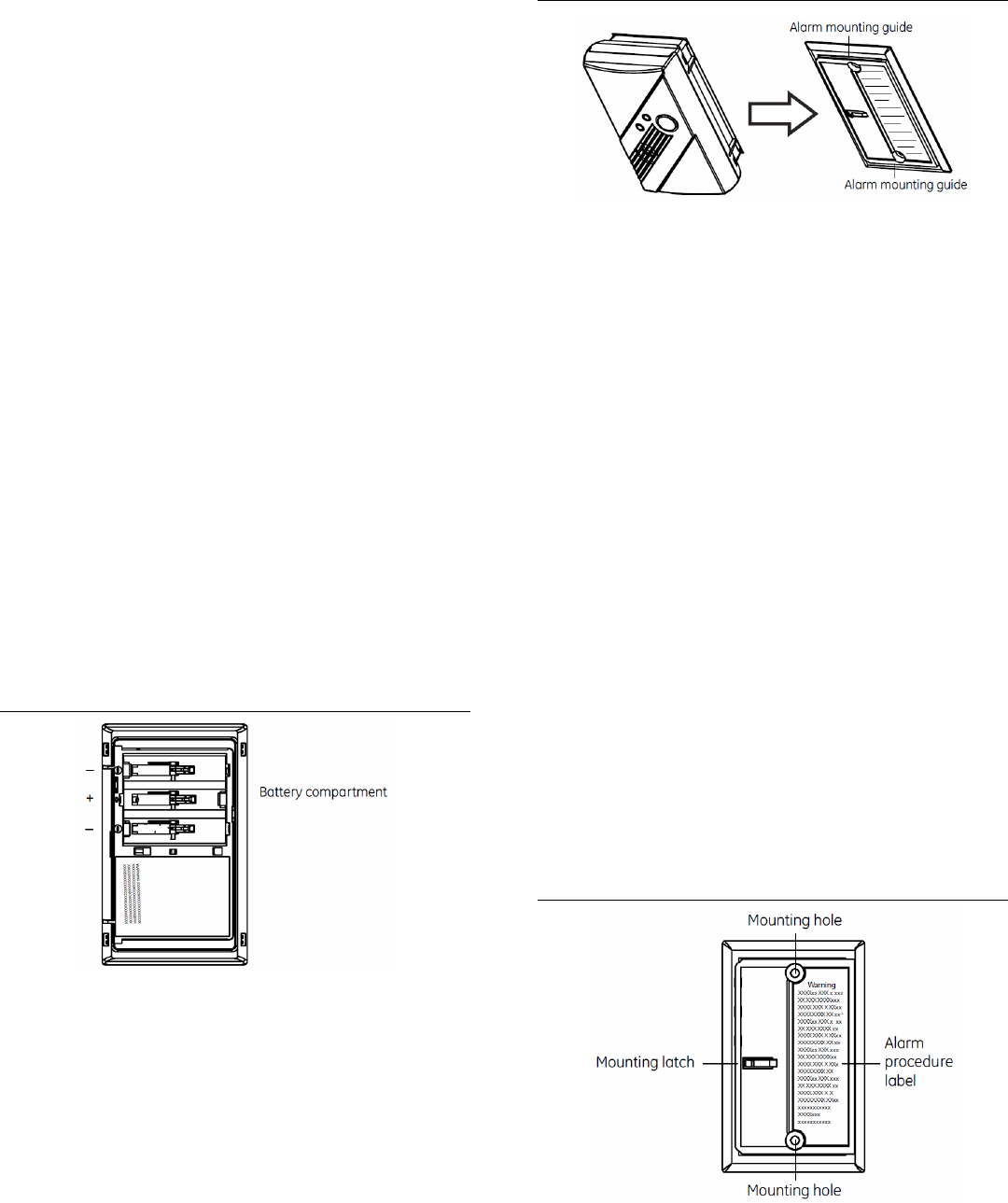
AT&T. All Rights Reserved. 2 P/N 0000 – Rev. A – 10 Oct 11
• Do not install on metal surfaces.
• Avoid mounting in areas with a large quantity of
metal or electrical wires.
• Do not install near ceiling fans, doors, windows, or
areas directly exposed to the weather.
• Do not install in dead air spaces, such as peaks of
vaulted ceilings or gabled roofs, where CO may not
reach the sensor in time to provide early warning.
• Do not install near deep-cell large batteries. Large
batteries have emissions that can cause the alarm to
perform at less than optimum performance.
• Do not obstruct the vents located on the alarm. Do
not place the alarm where drapes, furniture, or other
objects block the flow of air to the vents.
Battery installation and replacement
Note: Place the control panel into sensor test mode prior to
replacing the batteries. If the control panel is not in sensor test
mode during battery replacement, an alarm/tamper condition
may be indicated.
To install or replace the batteries in this alarm:
1. Slide the alarm body off of the mounting plate.
2. If replacing batteries, remove the old batteries and
properly dispose of them as recommended by the
battery manufacturer.
3. Install the new batteries. Note the polarity
illustration in the battery compartment (see Figure 3
below).
Figure 3: Batteries
4. Slide the alarm body back onto the mounting plate.
Note: The mounting plate will not close if all three
batteries are not installed.
Figure 4: Sliding the alarm on the mounting plate
5. Perform a sensor/RF test with the control panel.
See “RF communication test” on page 3
When replacing the batteries, use one of the following
approved brands:
• Duracell MN1500 or MX1500
• Energizer E91
Note: For battery replacement information, see interlogix.com.
Use of a different battery may have a detrimental effect
on the alarm operation.
Note: Constant exposures to high or low humidity may reduce
battery life.
After installing or changing the batteries, reinstall your
alarm. Test your alarm by using the Test/Hush button
and check that the green Power LED is on.
Mounting the alarm
Note: Verify RF performance prior to permanently mounting
the alarm. See “RF communication test” on page 3.
The CO Alarm can be wall mounted or ceiling mounted.
To mount the alarm:
1. Slide the alarm body off of the mounting plate.
Place the mounting plate in the desired location,
and mark the location of the two mounting holes.
Orient the mounting plate vertically or horizontally
as shown in the following figures.
Note: The alarm can also be directly mounted to a single gang
box.
Figure 5: Vertical mounting
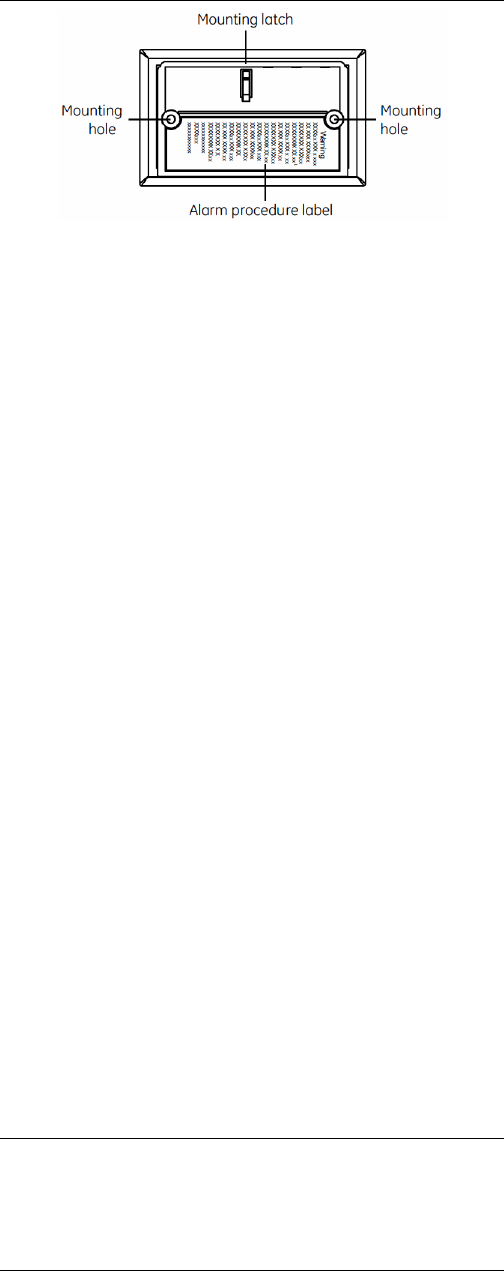
AT&T. All Rights Reserved. 3 P/N 0000 – Rev. A – 10 Oct 11
Figure 6: Horizontal Mounting
2. Insert the two screws provided and secure the
mounting plate to the wall or ceiling surface. (If
mounting in plasterboard or drywall, drill a 3/16 in.
hole and use the plastic anchors provided.)
3. After the mounting plate is secured, slide the alarm
over the mounting plate (see Figure 4 on page 2).
Important labels provided
Two labels have been provided that have important
information on what to do in case of an alarm. Add the
phone number of your emergency service provider in the
space provided. Place one label next to the alarm after it
is mounted, and one label near a fresh air source such
as a door or window.
Programming
The following section provides a general guideline for
programming (learning) the unit into control panel
memory. Refer to the panel documentation for complete
programming details.
To add the CO Alarm to panel memory:
1. Set the panel to program mode.
2. Proceed to the Learn/Add Sensors menu.
3. Select the desired sensor number.
4. Trip the wall tamper by removing the alarm body
from the mounting plate.
5. When the panel prompts you for sensor group
number, enter the appropriate group number based
on the system panel.
6. At the panel, exit program mode.
7. Place the alarm body back onto the mounting plate.
Note: Each CO Alarm is programmed with a unique ID when
manufactured. The unique ID is enrolled into the control panel
at the time of installation, allowing the CO alarm to
communicate with that specific control panel.
Testing
Note: This unit is sealed. The cover is not removable.
WARNING: The control panel must be placed into
sensor test mode while conducting any tests. Placing the
control panel into sensor test mode for all testing helps
to protect against false alarms and unintentional central
station reporting.
Due to the loudness of the alarm, we suggest that you
place your fingers over the sounder vent while testing
your alarm.
Caution: Continuous exposure to the high sound level of this
alarm over an extended period of time may cause hearing loss.
The CO Alarm provides three test modes:
• Normal CO Alarm test. Conducts an internal self
test and tests the sounder.
• RF communication test. Tests the communication
path with the control panel.
• CO Alarm functional gas test. Tests the functional
operation of the CO sensing element.
Normal CO Alarm test
1. Wait at least 10 minutes after installation to test the
CO Alarm.
2. Make sure the green Power LED is flashing for
normal operation.
3. Set the control panel to sensor test mode.
4. Press and hold the Test/Hush button until the unit
beeps once (approximately 1 second), and then
release the button. If the unit is operating properly,
you will hear four quick beeps, followed by 5
seconds of silence, followed by four quick beeps.
5. At the control panel, exit sensor test mode.
Note: This test mode does not test communication with the
control panel. You will receive a “Sensor Test Fail or Abort”
message when the control panel exits sensor test mode.
RF communication test
This section provides general guidelines for testing the
CO Alarm with the panel. Refer to the specific panel
documentation for complete testing details.
Before testing, ensure that your control panel is set to
sensor test mode. Setting your panel to sensor test
mode prevents an alarm signal from being transmitted to
the central monitoring station (if you have a monitored
system).
1. Wait at least 10 minutes after installation to test
the CO Alarm.
2. Make sure the green Power LED is flashing for
normal operation.
3. Set the control panel to sensor test mode.
4. Press and hold the Test/Hush button until the unit
beeps two times (approximately 5 seconds), and
then release the button. If the unit is operating
properly, you will hear four quick beeps. The unit
will send the RF test packets after the first four
beeps.
5. The control panel will beep and display the
number of RF packets received.
6. At the panel, exit sensor test mode.
CO inspection and functional gas test (for qualified
service technicians only)
Note: Consult the most recent version of NFPA 720 for more
information regarding the requirement for functional testing of
CO alarms and/or your Local Authority Having Jurisdiction
(AHJ).
A canned CO testing agent must be used for the CO
functional gas test.
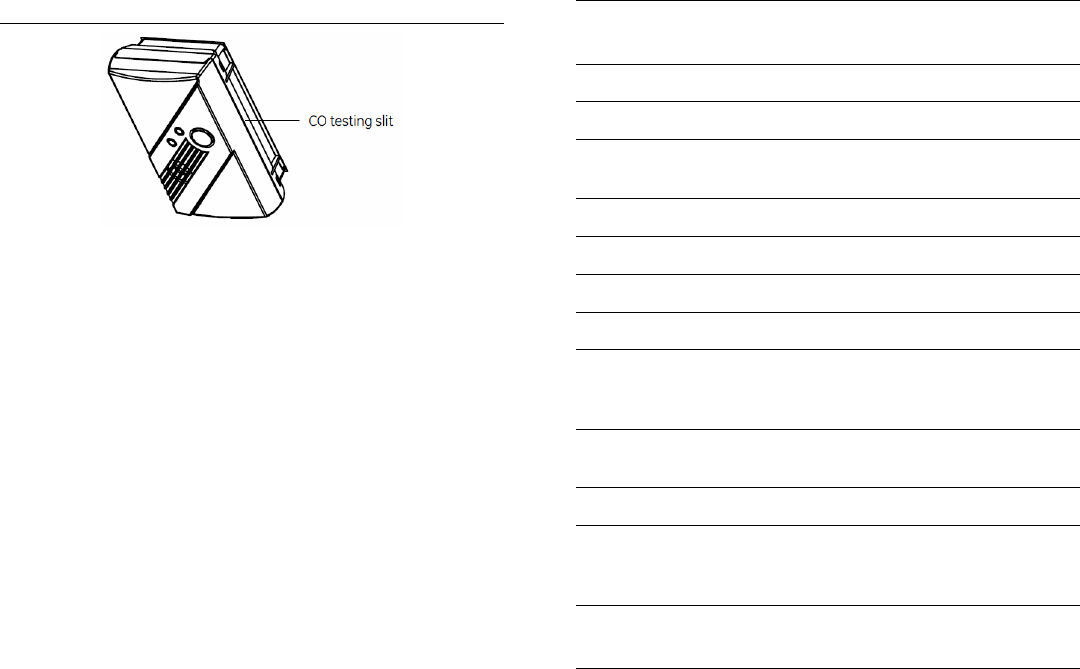
AT&T. All Rights Reserved. 4 P/N 0000 – Rev. A – 10 Oct 11
1. Wait at least 10 minutes after installation to test the
CO Alarm.
2. Make sure the green Power LED is flashing for
normal operation.
3. Set the control panel to sensor test mode.
4. Press and hold the Test/Hush button until the unit
beeps three times (approximately 10 seconds), and
then release the button. The unit will enter the
functional gas test mode. The Power LED will blink
once per second while in functional test mode.
5. Apply UL approved CO test agent to the slit as
shown in Figure 7 below. When CO is detected, the
unit will activate a CO Alarm. The unit will send RF
test packets to the control panel when the CO
Alarm is activated.
Figure 7: CO testing slit
6. The control panel will beep and display the number
of RF packets received.
7. At the control panel, exit sensor test mode.
8. Exit functional gas test mode:
9. Press and release the Test/Hush button; or A 2
minute timeout will automatically cause the CO to
return to normal operating mode.
Troubleshooting
This information is provided to help you diagnose and
solve various problems that may arise while configuring
or using the wireless CO Alarm.
Unit does not power up properly or reports low
battery:
• Make sure the batteries are fully seated within the
battery compartment and the polarity is correct.
• Make sure that all three batteries are installed.
• Check the battery voltage (1.5 VDC nominal per
battery).
Control panel does not respond:
• Use the 60-401 RF Sniffer to make sure the CO
Alarm is sending messages for activation.
• Move or rotate the CO Alarm position.
• Make sure the CO Alarm is properly enrolled into the
control panel.
• Make sure that you are using a compatible control
panel (see “Specifications” below).
Tamper condition does not restore:
• Make sure the CO Alarm body is properly installed
on the mounting plate.
• Make sure there are no trouble indications at the CO
Alarm.
• Make sure that you are using a compatible control
panel (see “Specifications” below).
If a tamper alarm occurs:
• Make sure that you are using a compatible control
panel (see “Specifications” below).
• Make sure that the control panel is in sensor test
mode during sensor testing.
Specifications
Compatible Panels Digital Life Controller
SKU #: RTL.69237
Power Three (3) AA batteries
Battery Type 1.5 VDC Alkaline
Required Batteries Duracell MN 1500, Duracell MX 1500
Energizer E91
Sensor Life 7 years
Frequency 433 Mhz
Supervisory Interval 64 minutes
Audible Alarm Temporal 4
Alarm Response times 70 PPM = 60-240 min.
150 PPM = 10-50 min.
400 PPM = 4-15 min.
Dimensions 4.68 x 2.75 x 1.85 in. (119 x 70 x 47
mm)
Storage Temperature - 4 to 140oF (- 20 to 60oC)
Operating Environment
Temperature 40 to 100oF (4.4 to 37.8oC)
Relative Humidity 10 to 95% non-condensing
Regulatory Information
ETL Rating ANSI/UL 2034
FCC Compliance
The device complies with part 15 of the FCC Rules devices as well as
Industry Canada Rules and Regulations licence-exempt RSS
standard(s). Operation is subject to the following two conditions: (1)
This device may not cause harmful interference, and (2) this device
must accept any interference received, including interference that may
cause undesired operation. Changes or modifications not expressly
approved by the party responsible for compliance could void the user’s
authority to operate the equipment.
Conformité Réglementaire
Ce dispositif est conforme à la réglementation de la IC et (Partie 15) de la
FCC. Son fonctionnement est soumis à deux conditions : (1) ce dispositif ne
doit pas causer d’interférences nuisibles, et (2) ce dispositif doit accepter
toute interférence reçue, y compris les interférences pouvant entraîner des
conditions de fonctionnement indésirables.

AT&T. All Rights Reserved. 5 P/N 0000 – Rev. A – 10 Oct 11
FCC ID: QNP- 433CO
IC: 4676A-433CO
Operation Characteristics
Table 1: Operation characteristics
LED Display
Alarm Sound
Units Status
Control Panel
Status
Recommendation
Normal operation
Green Power LED
flashes every 30
seconds.
None.
Normal DC
operation (sensing
no CO) and with
good batteries.
Normal operating
condition.
None.
Carbon monoxide alarm
Red Alarm LED
flashes with beeps.
Four quick beeps, 5
seconds silence,
repeating.
Alarm condition.
Dangerous
concentrations of
CO detected.
Alarm condition.
See “Alarm procedure” on page 8.
Low battery / low
battery hush
Red Alarm LED
flashes every 60
seconds.
One quick beep
every 60 seconds.
Batteries need to be
replaced.
Trouble condition,
trouble beeps every
60 seconds.
Replace all three AA batteries.
Press Test/Hush button and release.
This will silence the low battery audible
chirp between 8 and 11 hours allowing
for a more convenient time to replace
the batteries.
Alarm end-of-life
indicator
Red Alarm LED
flashes two times
every 30 seconds.
Two quick beeps
every 30 seconds.
End of CO Alarm
life.
Trouble condition,
trouble beeps every
60 seconds.
Press the Test/Hush button and
release. This will silence the end-of-life
signal for up to three days. After three
days, the unit will resume end-of-life
chirps. Hush mode will silence the
alarm ten times or up to 30 days. After
30 days, the unit can no longer be
hushed. Replace the CO Alarm
immediately. The unit will not respond
to CO.
Trouble/service alarm
Red Alarm LED
flashes every 30
seconds.
One quick beep
every 30 seconds.
Unit is in trouble
condition.
Trouble condition,
trouble beeps every
60 seconds.
Replace batteries. If condition
continues, unit has malfunctioned.
Replace immediately. Unit will not
respond to CO.
Error condition
Red Alarm LED
constantly on.
Constant alarm.
Very low battery or
unit malfunction.
Trouble condition,
trouble beeps every
60 seconds.
Replace batteries. If condition
continues, unit has malfunctioned.
Replace immediately. Unit will not
respond to CO.
Test mode
Red Alarm LED
flashes with beeps.
Four quick beeps, 5
seconds silence,
repeated once.
Normal operation
when Test/Hush
button is pressed.
Sensor test mode
CO not detected. Alarm for test
purposes only.
Tamper
Red Alarm LED
flashes every 30
seconds.
One quick beep
every 30 seconds.
Unit is in tamper
condition.
Trouble condition,
trouble beeps every
60 seconds.
Place alarm body back onto mounting
plate. If condition continues, unit has
malfunctioned. Replace immediately.
Maintenance tips
To keep your alarm in good working order:
• Perform a CO Alarm test once a week (see “Normal
CO Alarm test” on page 3).
• Vacuum the alarm cover once a month to remove
accumulated dust.
• Never use detergents or solvents to clean the alarm.
Chemicals can permanently damage or temporarily
contaminate the sensor.
• Avoid spraying air fresheners, hair spray, paint, or
other aerosols near the alarm.
• Do not paint the unit. Paint will seal the vents and
interfere with proper sensor operation.
• Move the CO Alarm to a remote location, to prevent
possible damage or contamination of the sensor,
prior to performing any of the following:
• Staining or stripping floors or furniture, painting
or wall-papering.
• Using aerosols or adhesives.
WARNING: Reinstall the CO Alarm as soon as possible
to assure continuous protection.
• The following is a list of substances that at high
levels can damage the CO sensor or cause
temporary readings that are not CO readings:
• Ethylene, ethanol, alcohol, iso-propanol,
benzene, toluene, ethyl acetate, hydrogen,
hydrogen sulfide, and sulfur dioxide.
• Also most aerosol sprays, alcohol-based
products, paint, thinner, solvent, adhesive, hair
spray, after shave, perfume, auto exhaust (cold
start), and some cleaning agents.
AT&T. All Rights Reserved. 6 P/N 0000 – Rev. A – 10 Oct 11
Information about carbon monoxide
Carbon monoxide is a colorless, odorless, and tasteless
poison gas that can be fatal when inhaled. CO inhibits
the blood’s capacity to carry oxygen.
Periodically review this alarm manual and discuss your
CO Alarm emergency procedure with all members of
your family. Never ignore a CO Alarm. A true alarm is an
indication of potentially dangerous levels of CO. CO
Alarms are designed to alert you to the presence of CO
before an emergency - before most people would
experience symptoms of CO poisoning, giving you time
to resolve the problem calmly.
Determine if anyone in the household is experiencing
symptoms of CO poisoning. Many cases of reported CO
poisoning indicate that while victims are aware they are
not well, they become so disoriented they are unable to
save themselves either by exiting the building or calling
for assistance. Also, young children and household pets
may be the first affected. You should take extra
precautions to protect high-risk persons from CO
exposure because they may experience ill effects from
CO at levels that would not ordinarily affect a healthy
adult.
Symptoms of CO poisoning
The following common symptoms are related to CO
poisoning and should be discussed with ALL members
of the household:
• Mild exposure = Slight headache, nausea, vomiting,
fatigue (often described as “flu-like” symptoms).
• Medium exposure = Severe throbbing headache,
drowsiness, confusion, fast heart rate.
• Extreme exposure = Unconsciousness, convulsions,
cardio-respiratory failure, death.
If you experience even mild symptoms of CO poisoning,
consult your doctor immediately.
Conditions that can produce carbon monoxide
• Excessive spillage or reverse venting of fuel burning
appliances caused by:
• Outdoor ambient conditions such as wind direction
and/or velocity, including high gusts of wind; heavy air
in the vent pipes (cold/humid air with extended
periods between cycles).
• Negative pressure differential resulting from the use
of exhaust fans.
• Simultaneous operation of several fuel burning
appliances competing for limited internal air.
• Vent pipe connection vibrating loose from clothes
dryers, furnaces, or water heaters.
• Obstructions in or unconventional vent pipe designs
which amplify the above situations.
• Extended operation of unvented fuel burning devices
(range, oven, fireplace, etc.).
• Temperature inversions which can trap exhaust
gasses near the ground.
• Car idling in an open or closed attached garage, or
near a home.
What CO alarms can and cannot do
CO Alarms provide early warning of the presence of CO,
usually before a healthy adult would experience
symptoms. This early warning is possible however, only
if your CO Alarm is located, installed, and maintained as
described in this manual.
Because carbon monoxide is a cumulative poison, long-
term exposures to low levels may cause symptoms, as
well as short-term exposures to high levels. This unit has
a time-weighted alarm; the higher the level of CO
present, the sooner the alarm will be triggered.
This CO Alarm can only warn you of the presence of
CO. It does not prevent CO from occurring, nor can it
solve an existing CO problem. If your unit has alarmed
and you’ve provided ventilation by leaving your windows
and doors open, the CO buildup may have dissipated by
the time help responds. Although your problem may
appear to be temporarily solved, it is crucial that the
source of the CO is determined and that the appropriate
repairs are made.
CO Alarms have limitation. Like any other electronic
device, CO Alarms are not fool-proof. CO Alarms have a
limited operational life. You must test your CO alarm
weekly, because it could fail to operate at any time.
If your CO Alarm fails to test properly, or if its self-
diagnostic test reveals a malfunction, immediately have
the unit replaced. This alarm will not monitor CO levels
while in a trouble condition.
CO Alarm can only sense CO that reaches the unit’s
sensor. It is possible that CO may be present in other
areas without reaching the alarm. The rate and ability
with which CO reaches the alarm may be affected by:
• Doors or other obstructions.
• Fresh air from a vent, an open window, or other
source.
• CO being present on one level of the home and not
reaching a CO Alarm installed on a different level.
(For example, CO in the basement may not reach an
alarm on the second level, near the bedrooms).
For these reasons, we recommend you provide
complete coverage by placing a CO Alarm on every level
of the home.
CO Alarms should not be used to detect the presence of
natural gas (methane), propane, butane, or other
combustible fuels.
Instruct children never to touch or otherwise interfere
with the alarm. Warn children of the dangers of CO
poisoning.
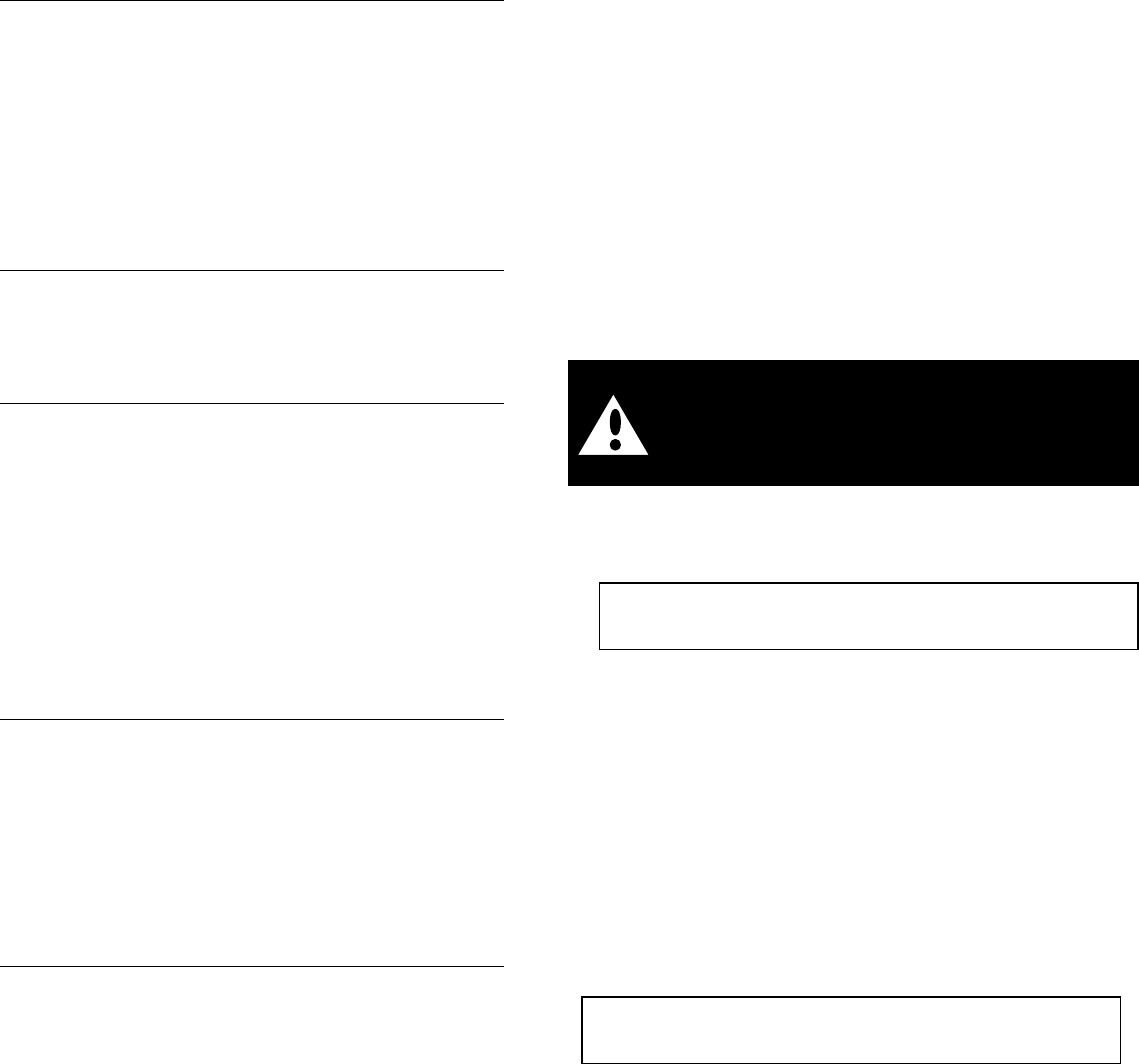
AT&T. All Rights Reserved. 7 P/N 0000 – Rev. A – 10 Oct 11
Important warning statements
This carbon monoxide alarm is designed to detect
carbon monoxide from ANY source of combustion. It is
NOT designed to detect smoke, fire, or any other gas.
WARNING: Carbon monoxide alarms are not smoke
alarms. This carbon monoxide alarm is not a substitute
for installing and maintaining an appropriate number of
smoke alarms in your home. This CO alarm will not
sense smoke, fire, or any poisonous gas other than
carbon monoxide even though carbon monoxide can be
generated by fire. For this reason you must install smoke
alarms to provide early warning of fire and to protect you
and your family from fire and its related hazards.
Caution: This alarm will only indicate the presence of
carbon monoxide at the sensor. Carbon monoxide may
be present in other areas.
WARNING: This product is intended for use in ordinary
indoor locations of family living units. It is not designed to
measure compliance with Occupational Safety and
Health Administration (OSHA), commercial, or industrial
standards. It is not suitable for installation in hazardous
locations as defined in the National Electric Code. The
installation of this device should not be used as a
substitute for proper installation, use and maintenance of
fuel burning appliances, including appropriate ventilation
and exhaust systems. It does not prevent CO from
occurring, nor can it solve an existing CO problem.
WARNING: This device is designed to protect
individuals from acute effects of carbon monoxide
exposure. It may not fully safeguard individuals with
specific medical conditions. If in doubt, consult a medical
practitioner. Individuals with medical problems may
consider using warning devices which provide audible
and visual signals for carbon monoxide concentrations
under 30 PPM.
This carbon monoxide alarm requires a continuous
supply of electrical power - it will not work without power.
This alarm has not been investigated for carbon
monoxide detection below 70 PPM.
Contact information
For residential consumers, please contact your local
security system installation company for product
replacement service.
Product returns from security professionals and
installers
For all product returns, including warranty
repair/replacements, non-warranty repairs, advance
replacements, and credit returns call AT&T at 1-855-
288-2727
Manufacturing information
Manufactured by Interlogix, a UTC Fire and Security
company, 1275 Red Fox Road, Arden Hills, MN 55112.
Carbon Monoxide Alarm Procedure
1. Operate the Test/Hush button;
2. Call your emergency services (Fire Department
or 911);
3. Immediately move to fresh air – outdoors or by
an open door/window. Do a head count to
check that all persons are accounted for. Do not
reenter the premises nor move away from the
open door/window until the emergency services
responders have arrived, the premises have
been aired out, and your alarm remains in its
normal condition.
4. After following steps 1-3, if the alarm reactivates
within a 24 hour period, repeat steps 1 – 3 and
call a qualified appliance technician to
investigate sources of CO from fuel burning
equipment and appliances, and to inspect for
proper operation of equipment.
If problems are identified during this inspection, have the
equipment serviced immediately. Note any combustion
equipment not inspected by the technician and consult
the manufacturer’s instructions, or contact the
manufacturer directly for more information and CO
safety and the equipment. Make sure that motor
vehicles are not , or have not been, operating in a
garage attached or adjacent to the residence.
PHONE NUMBER:
PHONE NUMBER:
Warning:
Activation of the CO Alarm
indicates the presence of Carbon Monoxide
(CO) which can kill you.
AT&T. All Rights Reserved. 8 P/N 0000 – Rev. A – 10 Oct 11
Never restart the source of a CO problem until it has
been corrected. Never ignore the sound of the
alarm!
If the alarm is sounding, pressing the test/reset
button will terminate the alarm. If the CO condition
that caused the alert in the first place continues, the
alarm will reactivate. If the unit alarms again within
six minutes, it is sensing high levels of CO which
can quickly become a dangerous situation.